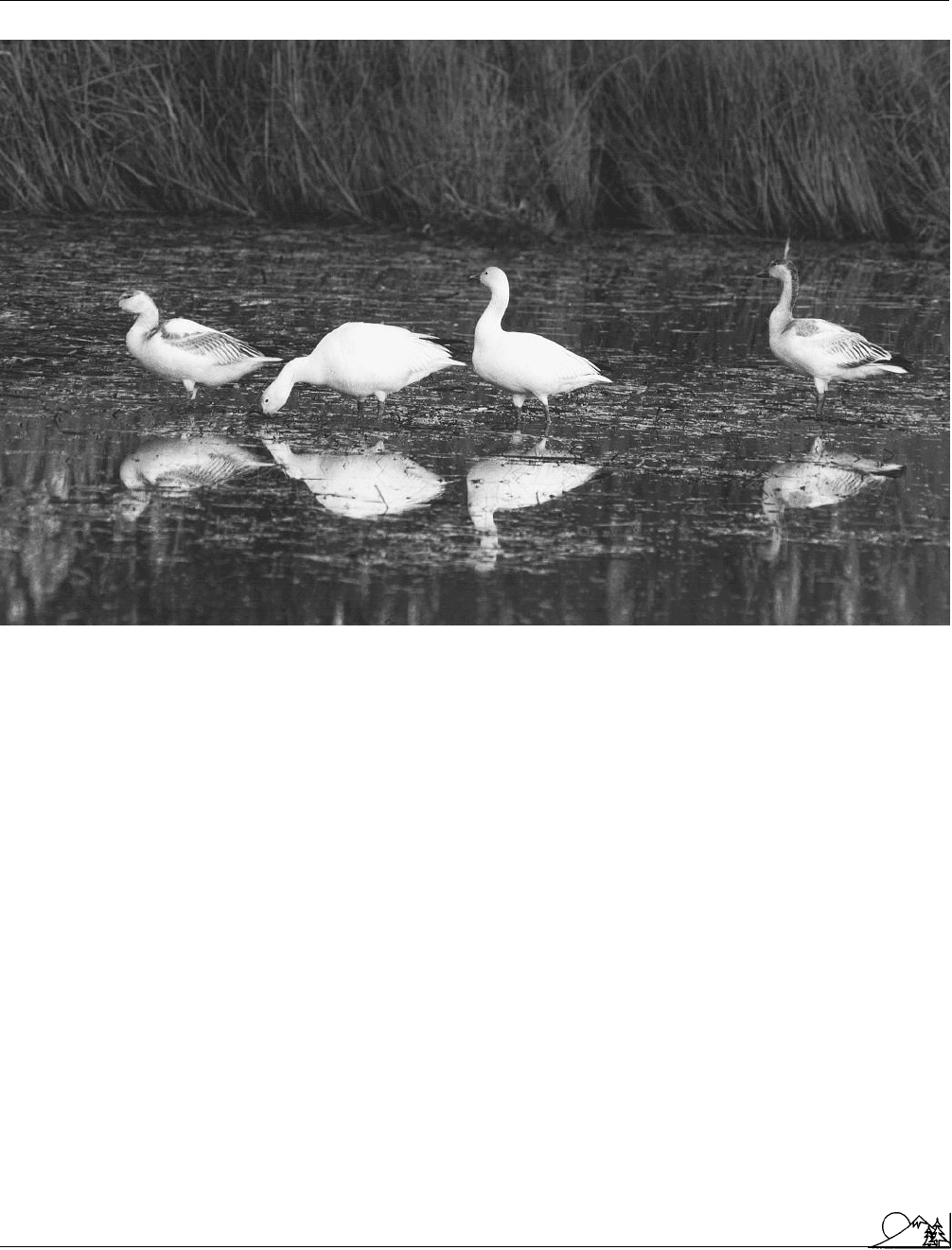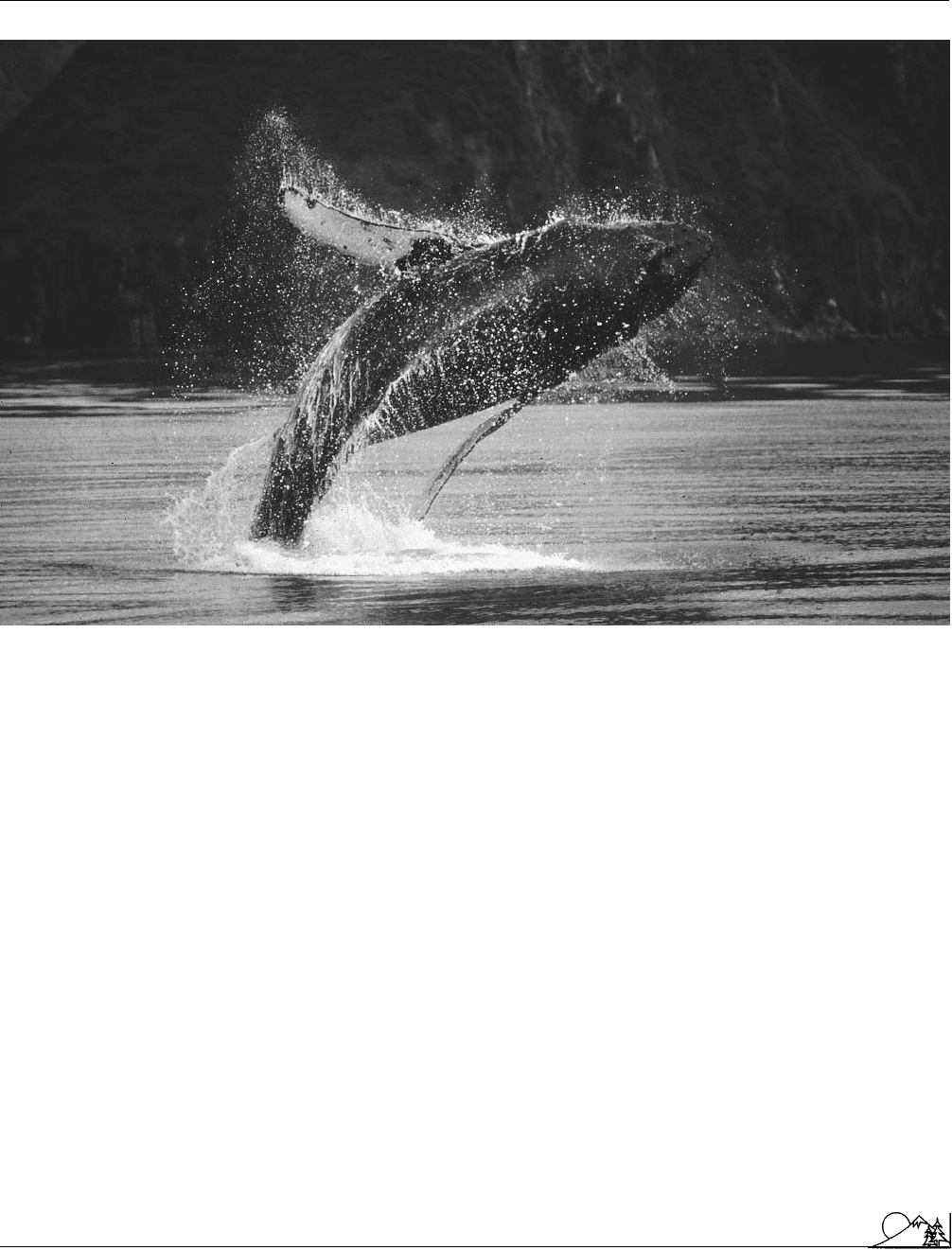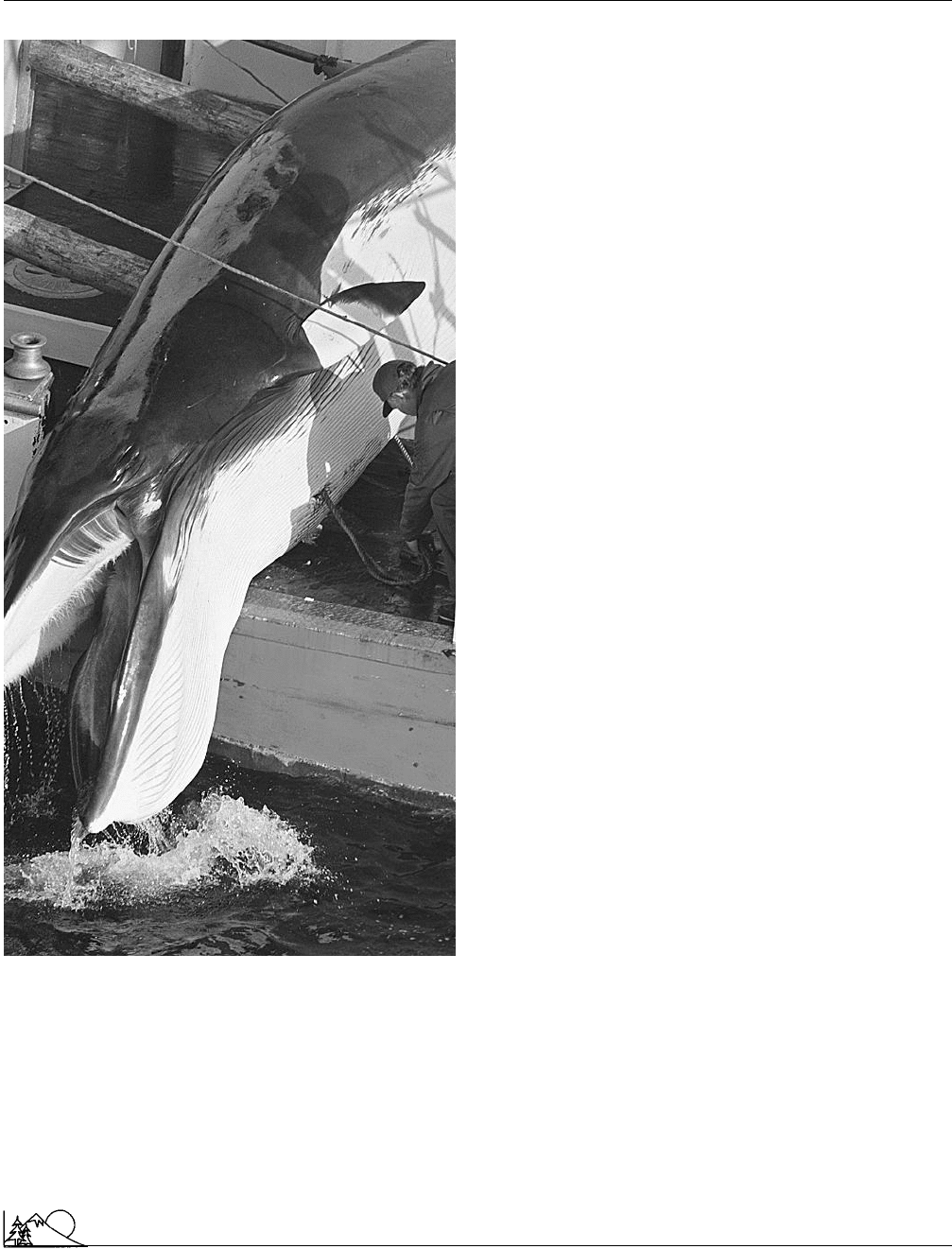Environmental Encyclopedia
Подождите немного. Документ загружается.


Environmental Encyclopedia 3
Weather modification
Cities, with their clustered buildings and canyons of
thoroughfares, absorb infrared heat and inadvertently modify
weather because their shape alters the flow of winds. Because
they are localized islands of heat, cities increase cloudiness.
Aerosols, or microscopic dust particles, given off in industrial
smoke
, bond with water vapor and create city
haze
and
smog
. When the aerosols contain
sulfur dioxide
and
nitro-
gen oxides
, they cause
acid rain
. Increased urban traffic
raises levels of
carbon monoxide
and
carbon dioxide
.In
the sky, jet trails contribute to the formation of clouds.
Fossil fuels
, which are ancient organic matter, release
CO
2
when they are burned. This collects in the greenhouse
band, a protective shield that circles the earth. Naturally
composed of CO
2
,
methane
, chlorofluorocarbons (CFCs),
nitrous oxide
, and water vapor, the greenhouse layer pro-
cesses infrared heat sent back into space by earth and regu-
lates the temperature of the earth. When it is too full to
allow infrared heat from earth to pass through into space,
the temperature rises on earth, affecting local, regional, and
global weather.
Intentional weather modification involves taking ad-
vantage of the energy contained within weather systems and
turning it toward a specific goal. To “make” rain, a scientist
mimics the natural process by introducing extra water drop-
lets or ice crystals in clouds. However, he needs the right
cloud shapes with the right internal temperature and the
right winds, headed in the direction of his target.
Rainmaking became a serious science in 1950 when
physicist Bernard Vonnegut at General Electric devised a
way to vaporize silver iodide to let it rise on heated air
currents into clouds where it solidified and bonded onto
water droplets to create ice crystals. Previous attempts at
rainmaking involved dropping dry ice (solid CO
2
) onto
clouds from planes, but this was expensive. Vonnegut chose
silver iodide because its molecular structure most closely
matches that of ice crystals.
In California, where the Southern California Edison
Company regularly sends out planes to seed rain clouds over
the dry San Joaquin Valley farmland, silver iodide is shot
from rockets mounted on the leading edge of the wings. It is
also vaporized into clouds from ground generators at higher
altitudes in the Sierra Mountains. In rainmaking projects,
the purpose is to avoid droughts, increase food productivity,
and augment water supplies for drinking or hydroelectric
plants. But gathering accurate data on successful seeding
and subsequent precipitation has been difficult. Currently,
most scientists agree with a longterm analysis that seasonal
cloud seeding has increased precipitation by at least 10%,
possibly as much as 20%. Clouds, which are ever-moving
collections of water vapor, regulators of heat, and generators
of tremendous internal winds, remain mysterious. Yet they
are major players in earth’s climate.
1497
Other weather modification projects include dissipat-
ing cold fogs, done routinely at major airports around the
world. In the former Soviet Union, damaging hailstorms
were successfully broken up to protect ripening crops. How-
ever,
statistics
from attempts at hail suppression in the
United States have been inconclusive, and research is ongo-
ing. In the 1950s and 1960s, scientists experimented with
seeding hurricanes to diminish the storms’ severity and alter
their path. Similarly, attempts were made to “explode” torna-
does by firing artillery into the oncoming storms. In both
cases, natural energies far exceeded any attempts at control.
“We don’t have the capability to turn the weather
around,” said Bill Blackmore of
National Oceanic and
Atmospheric Administration
(NOAA)’s Weather Modifi-
cation Reporting Program. “If we could modify the weather
a hundred percent then we could predict the weather a
hundred percent. What we need is a lot more understanding
of its complexity.”
NOAA funds the Federal State Coop Program, a six-
state research group. The Atmospheric Modification Pro-
gram at NOAA’s Wave Propagation Lab in Boulder, Colo-
rado, coordinates and evaluates state projects. Research there
and at the Institute for Atmospheric Science at the South
Dakota School of Mines and Technology involves doing
remote sensing of clouds, computer modelling of clouds, and
releasing tracers in convective clouds to better understand the
dynamics of thunderstorms.
A new way of collecting rainwater is cloud “milking.”
Researchers have been collecting fog on the mountains of
Chile by stringing 50 nylon mesh nets—39 ft (11.8 m) long
by 13 ft (4 m) wide—at regular intervals on the mountain-
side. As the windblown fogs hit the net, they trap water
particles. These are then collected into containers. On aver-
age, the system “milks” 2,500 gal (9,475 L) of drinking water
a day.
Most rainmaking activities in the United States take
place in the western states and are sponsored by water depart-
ments or districts and conducted by private and commercial
companies. The mistakes made earlier in the history of alter-
ing the weather have been dealt with by regulations in each
state. Internationally, the World Meteorological Organiza-
tion (WMO) oversees weather modification, and the Treaty
of War and Environmental Weather, signed at the Geneva
Arms Limitation Talks in 1977, forbids uncontrolled mili-
tary weather modification.
In 1971, the United States created Public Law 92-
205, which requires states to file all weather modification
activity with the NOAA’s Weather Modification Reporting
Program. Typically, about a dozen states file annually.
Two private organizations, the American Meteorolog-
ical Society in Boston, Massachusetts, and the Weather
Modification Association of Fresno, California, keep records

Environmental Encyclopedia 3
Weathering
on weather modification. The Journal of Weather Modifica-
tion is an annual publication of the Institute for Atmospheric
Science at the South Dakota School of Mines and Technol-
ogy. See also Deforestation; Greenhouse effect; Ozone;
Ozone layer depletion
[Stephanie Ocko]
R
ESOURCES
B
OOKS
Arnett, D. S. Weather Modification by Cloud Seeding. New York, Academic
Press, 1980.
Breuer, G. Weather Modification: Prospects and Problems. New York: Cam-
bridge University Press, 1979.
P
ERIODICALS
“Planned and Inadvertent Weather Modification.” Bulletin of the American
Meteorological Society (March 1992): 331–337.
Strauss, S. “To Catch a Cloud.” Technology Review (May-June 1991): 18–19.
O
THER
Blackmore, W. H. A Summary of Weather Modification Activities Reported
in the United States During 1991. Silver Spring, MD: National Oceanic
and Atmospheric Administration, 1991.
Weathering
Weathering refers to the group of physical, chemical, and
biological processes that change the physical and chemical
state of rocks and soils at and near the surface of the earth.
Weathering is primarily a result of climatic forces. Because
the effects of
climate
occur at the earth’s surface, the inten-
sity of weathering decreases with depth, with most of the
effects exhibited within the first meter of the surface. The
most important climatic force is water, as it moves in and
around rocks and
soil
.
Physical weathering is the disintegration of rock into
smaller pieces by mechanical forces concentrated along rock
fractures. Abrasion of rocks occurs when wind or water carry
particles that wear away rocks. Physical weathering due to
frost is referred to as frost shattering or frost wedging. Be-
cause water expands when it freezes, it can break rocks apart
from the inside when it seeps into cracks in a rock or soil.
The specific volume (volume/unit mass) of water increases
by 9% during freezing, which produces a stress that is greater
than the strength of most rocks. Frost action is the most
common physical weathering process, as frost is widespread
throughout the world. Frost even occurs in the tropics at
high elevations, and as a weathering force, is most effective
in coastal arctic and alpine environments, where there are
hundreds of frost (freeze-thaw) cycles per year.
Exfoliation is the breaking off of rocks in curved sheets
or slabs along joints that are parallel to the ground surface.
Exfoliation occurs when a rock expands in response to the
1498
removal of adjacent rock. Most commonly the release of
stress upon a rock occurs when overlying rock is eroded away
(i.e., when the pressure of deep burial is removed). The
rock breaks apart along expansion fractures that increase in
spacing with depth.
Another type of physical weathering is salt wedging.
Most water as it moves through the earth contains dissolved
salts; in some areas the salt content may be high, with
possible sources being seawater or chemical weathering of
marine sediments. As the saline water moves into rock frac-
tures and subsequently evaporates, salt crystals form. As the
process continues, the crystals grow until they act as a wedge
and crack and break the rocks. Salt wedging most commonly
occurs in dry landscapes where the
groundwater
is near
the surface.
Hydration is a physical process that also results in
weathering. Soil aggregates and fine-grained rocks can disin-
tegrate due to wetting and drying cycles and the expansion
and contraction associated with the cycles. Also air that is
drawn into pores under dry conditions and then trapped as
water returns to the soil or rock can cause fracturing.
Thermal weathering is another physical process. Re-
peated daily heating and cooling of rock results in expansion
during heating and contraction during cooling. Different
materials expand and contract at different rates, resulting in
stresses along mineral boundaries.
Chemical weathering of rocks or soils occurs through
chemical reactions when rocks or soils react with water,
gases, and solutions. During these chemical reactions, miner-
als are added or removed or are decomposed into other
materials such as
clay minerals
.
Carbon dioxide
, a chemical weathering agent, dis-
solves in rain and forms a weak carbonic
acid
. This weak
acid, through the process of carbonation, can dissolve rocks
such as limestone and feldspar. Carbonation of limestone
can result in the formation of karst
topography
that may
include caves, disappearing streams, springs, and
sinkholes
.
In chemical oxidation weathering, rocks are trans-
formed through reactions with oxygen dissolved in water.
Iron, often found in silicate minerals, is the most commonly
oxidized mineral element, when ferrous iron (Fe
+2)
) is oxi-
dized to ferric iron (Fe
+3
). Color changes often indicate when
oxidation has occurred, such as the “rusting” seen with the
oxidation of iron. Other readily oxidized minerals include
magnesium, sulfur,
aluminum
, and chromium.
Hydrolysis is the most common weathering process,
where mineral cations in a rock or soil mineral are replaced
by
hydrogen
(H
+
) ions. Pure water is a poor hydrogen
donor, but
carbon
dioxide dissolved in water, which pro-
duces carbonic acid, acts as a source of hydrogen ions.
Weathering products formed include clay minerals.

Environmental Encyclopedia 3
Wells
Biological weathering occurs when organisms aid in
the breakdown of rocks and minerals. Plants such as
lichens
and mosses produce a weak acid that dissolves geological
materials. Plant roots growing in the cracks of rocks, through
the process of root pry, can make the crack larger and may
loosen other types of materials.
[Judith L. Sims]
R
ESOURCES
B
OOKS
Ollier, Cliff, and Colin Pain. Regolith, Soils, and Landforms. New York:
John Wiley & Sons Ltd., 1996.
Rolls, David, and Will J. Bland. Weathering: An Introduction to the Basic
Principles. London: Edward Arnold, 1998.
Spickert, Diane Nelson, and Marianne D. Wallace. Earthsteps: A Rock’s
Journey Through Time. Golden, CO: Fulcrum Publishing, 2000.
WEE
see
Erosion
Wells
A well is a hydraulic structure for withdrawal of
ground-
water
from aquifers. A well field is an area containing two
or more wells. Most wells are constructed to supply water
for municipal, industrial, or agricultural use. However, wells
are also used for
remediation
of the subsurface (extraction
wells), recording water levels and pressure changes (observa-
tion wells), water-quality monitoring and protection (moni-
toring wells), artificial recharge of aquifers (injection wells),
and the disposal of liquid waste (
deep-well injection
). Vac-
uum extraction system is a new technology for removing
volatile contaminant from the unsaturated zone, in which
vapor transport is induced by withdrawing or injecting air
through wells screened in the
vadose zone
.
Well construction consists of several operations: (1)
drilling; (2) installing the casing; (3) installing a well screen
and filter pack; (4) grouting; and (5) well development.
Various well-drilling technologies have been devel-
oped because geologic conditions can range from hard rock
such as granite to soft, unconsolidated geologic formation
such as alluvial sediments.
Selection of a drilling method also depends on the
type of the well that will be installed in the borehole, such
as a water-supply well or a monitoring well. The two most
widely used drilling methods are cable-tool and rotary drill-
ing. The cable-tool percussion method is a relatively simple
drilling method developed in China more than 4,000 years
ago. Drilling rigs operate by lifting and dropping a string
of drilling tools into the borehole. The drill bit crushes and
1499
loosens rock into small fragments that form a
slurry
when
mixed with water. When the slurry has accumulated so the
drilling process is significantly slowed down, it is removed
from the borehole with a bailer. In rotary drilling, the bore-
hole is drilled by a rotating bit, and the cuttings are removed
from the borehole by continuous circulation of drilling fluid.
Boreholes are drilled much faster with this method, and at
a greater depth than with the cable-tool method. Other
drilling methods include air drilling systems, jet drilling,
earth augers, and driven wells.
Though well design depends on hydrogeologic condi-
tions and the purpose of the well, every well has two main
elements: the casing and the intake portion or screen. A
filter pack of gravel is often placed around the screen to assure
good porosity and hydraulic conductivity. After placing the
screen and the gravel filter pack, the annular space between
the casing and the borehole wall is filled with a slurry of
cement or clay. The last phase in well construction is well
development. The objective is to remove fine particles
around the screen so hydraulic efficiency is improved.
A well is fully penetrating if it is drilled to the bottom
of an
aquifer
and is constructed in such a way that it
withdraws water from the entire thickness of the aquifer.
Wells are also used for conducting tests to determine
aquifer and well characteristics. During an aquifer test, a
well is pumped at a constant
discharge
rate for a period of
time, and observation wells are used to record the changes
in hydraulic head, also known as drawdown. The radius of
influence of a pumping well is the radial distance from the
center of a well to the point where there is no lowering of
the
water table
or potentiometric surface (the edge of its
cone of depression). The collected data are then analyzed
to determine hydraulic characteristics. A pumping test with
a variable discharge is often used to determine the capacity
and the efficiency of the well. A slug test is a simple method
for estimating the hydraulic conductivity of an aquifer, a
rapid water level change is produced in a piezometer or
monitoring well, usually by introducing or withdrawing a
“slug” of water. The rise or decline in the water level with
time is monitored. The data can be analyzed to estimate
hydraulic conductivity of the aquifer.
The predominant tool for extracting vapor or contami-
nated groundwater from the subsurface is a vertical well.
Howerver, in many situations where environmental remedia-
tion is necessary, a horizontal well offers a better choice,
considering aquifer geometry, groundwater flow patterns,
and the geometry of contaminant plumes. Extraction of
contaminated groundwater is often more efficient with hori-
zontal wells; a horizontal well placed through the core of a
plume
can recover higher concentrations of contaminants
at a given flow rate than a vertical well. In other cases,
horizontal wells may be the only option, as contaminants

Environmental Encyclopedia 3
Adam Werbach
are often found directly beneath buildings, landfills, and
other obstacles to remedial operations. See also Aquifer resto-
ration; Drinking-water supply; Groundwater monitoring;
Groundwater pollution; Water table; Water table draw-
down
[Milovan S. Beljin]
R
ESOURCES
B
OOKS
Campbell, M., and J. H. Lehr. Water Well Technology. New York: McGraw-
Hill, 1973.
Driscoll, F. G. Groundwater and Wells. St. Paul: Johnson Filtration Sys-
tems, 1986.
Nielsen, D. A., and A. I. Johnson. Ground Water and Vadose Zone Monitor-
ing. Philadelphia: ASTM, 1990.
Adam Werbach (1972 – )
American environmentalist
Adam Werbach was born in Tarzana, California, the second
son of a psychiatrist father and therapist mother. His strong
environmental conscience was nurtured by his parents, who
were both activists in the
Sierra Club
. Werbach became a
Sierra Club member himself at age 13 and formed the Sierra
Student Coalition (SSC) at age 19, composed of 300,000
members. He served two years on the Sierra Club’s Board
of Directors as a member of the Club’s national membership
committee and volunteer development committee. Then on
May 18, 1996, at the age of only 23, Werbach was elected
president of the Sierra Club.
It was
David Ross Brower
, 60 years older than Wer-
bach, who ran the campaign for Werbach to be elected
president by the 15-member board, which in turn is elected
by the Sierra Club membership at large. As the youngest
president ever to
lead
the Sierra Club, Werbach works
with the executive director and other staff to manage an
organization of about 600,000 members and a $44 million
annual budget. The average age of Sierra Club members is
around 47, emphasizing the fact that younger generations
are currently under-represented in the environmental fields.
One of Werbach’s goals is to recruit this younger group by
appealing to what interests them—the present and how it
will affect their personal future.
Werbach believes: “The
environment
is the primary
issue that prompts this generation, my generation, to take
social and political action. Our job is to get the word out
to them and to give them a place to act on their anxieties
and convictions. My goal is to make that place the Sierra
Club.”
As a high school student, Werbach founded and served
as the first director of the Sierra Club’s national student
1500
program, the Sierra Student Coalition, which has trained,
registered, and involved thousands of students in all states
with Sierra Club
conservation
campaigns. He also orga-
nized a conference of environmental youth leaders from 20
countries for the first World Youth Leadership Camp in 1996.
During this same year he earned a B.A. from Brown with
a double major in Political science and Modern culture and
media.
Werbach has many hobbies, including music, and has
toured the United States, Europe, and Asia, singing baritone
and playing the guitar with a men’s vocal group at Brown
University. He has also written several journal articles and
a novel entitled Whirled, and has worked on several films
concerning both natural- and socially-constructed environ-
ments. His book Act Now, Apologize Later was published in
1998 and prompted others of his generation to become
much more aware of the world around them. Werbach also
currently runs a cable access show, The Thin Green Line,
which focuses on the environment.
[Nicole Beatty]
Wet scrubber
Wet
scrubbers
are devices used to remove pollutants from
flue gases. They consist of tanks in which flue gases are
allowed to mix with liquid. If the pollutant to be removed
is soluble in water, water alone can be used as the scrubbing
agent. However, most scrubbers are used to remove
sulfur
dioxide
, which is not sufficiently soluble in water. Thus,
the liquid used in such cases is one that will chemically react
with the sulfur dioxide. A solution of sodium carbonate
is such a liquid. When sulfur dioxide reacts with sodium
carbonate, it forms sodium sulfite, which can be drawn off
at the bottom of the tank. See also Flue-gas scrubbing
Wetlands
During the last four decades, several definitions of the term
“wetland” have been offered by different sources. Today’s
legal and jurisdictional delineations were published in the
Corps of Engineers Wetlands Delineation Manual and revised
in 1989. It states that wetlands are “those areas that are
inundated or saturated by surface or ground water at a fre-
quency and duration sufficient to support, and that under
usual circumstances support a prevalence of vegetation typi-
cally adapted for life in saturated
soil
conditions.”
For an area to be a wetland, it must have certain
hydrology
, soils, and vegetation. Vegetation is dominated
by
species
tolerant of saturated soil conditions. They exhibit
a variety of adaptations that allow them to grow, compete,

Environmental Encyclopedia 3
Wetlands
and reproduce in standing water or waterlogged soils lacking
oxygen. Soils are wet or have developed under permanent
or periodic saturation. The
hydrologic cycle
produces
an-
aerobic
soils, excluding a strictly upland plant community.
There are seven major types of wetlands that can be
divided into two major groups: coastal and inland. Coastal
wetlands are those that are influenced by the ebb and flow
of tides and include tidal salt marshes, tidal freshwater
marshes, and mangrove swamps. Salt marshes exist in pro-
tected coastlines in the middle to high latitudes. Plants and
animals in these areas are adapted to
salinity
, periodic
flood-
ing
, and extremes in temperature. These marshes are preva-
lent along the eastern and Gulf coasts of the United States
as well as narrow belts on the west coast and along the
Alaskan coastline.
Tidal freshwater marshes occur inland from the tidal
salt marshes and host a variety of grasses and perennial
broad-leaved plants. They are found primarily along the
middle and south Atlantic coasts and along the coasts of
Louisiana and Texas.
Mangrove swamps occur in subtropical and tropical
regions of the world. Mangrove refers to the type of salt-
tolerant trees that dominate the vegetation of this wetland.
These wetlands are only found in a few places in the United
States; the largest areas are found in the southern tip of
Florida.
Inland wetlands, which constitute the majority of wet-
lands in the United States, occur across a variety of climatic
zones. They can be divided into four types: northern
peat-
lands
, southern deep water swamps, freshwater marshes,
and riparian ecosystems.
Freshwater marshes represent a variety of different
inland wetlands. They have shallow water, peat accumula-
tion, and grow cattails, arrowheads, and different species of
grasses and sedges. Major freshwater marshes include the
Florida
Everglades
,
Great Lakes
coastal marshes, and areas
of Minnesota and the Dakotas.
Southern deepwater swamps are freshwater woody
wetlands with standing water for most of the growing season.
The most recognizable type of vegetation is cypress. They
are either fed by rainwater or occur in alluvial positions
that are annually flooded. These wetlands are found in the
southeast United States.
Northern peatlands consist of deep accumulation of
peat. Primary locations are Minnesota, Wisconsin, Michi-
gan, areas of the Northeast that have been affected by the
last
glaciation
, and some mountain and coastal bays in the
southeast. Bogs are marshes or swamps that lack contact
with local
groundwater
and are acidified by organic acids
from plants. They are noted for
nutrient
deficiency and
waterlogged conditions with vegetation adapted to conserve
nutrients in this
environment
.
1501
Riparian forested wetlands, occurring along rivers and
streams, are occasionally flooded but generally dry for a large
part of the growing season. The most common type of
wetland in the United States, they are often productive be-
cause of the periodic addition of nutrients with
sediment
deposited during floods.
Wetlands are valuable in several ways. Because of their
appearance and
biodiversity
alone, wetlands are a valuable
resource. Many types of
wildlife
, including
endangered
species
such as the
whooping crane
and the alligator,
inhabit or use wetlands. Over 50% of the 800 species of
protected migratory birds rely on wetlands. Wetlands are
valuable for
recreation
, attracting hunters of ducks and
geese. Over 95% of the fish and shellfish that are taken
commercially depend on wetland
habitat
in their life cycles.
Forest wetlands are an important source of lumber.
Other wetland vegetation, such as cattails or woody shrubs,
could someday be harvested for energy production. Peat is
used in potted plants and as a soil amendment, particularly
to grow grass sod.
Wetlands intercept and store storm waters, reducing
the peak
runoff
and slowing stream discharges, reducing
flood damage. In coastal areas, wetlands act as buffers to
reduce the energy of ocean storms before they reach more
populated areas and cause severe damage. Although most
wetlands do not, some may recharge underlying ground-
water. Wetlands can improve surface
water quality
by the
removal of nutrients and toxic materials as water runs over or
through it. Most importantly, wetlands may play a significant
role in the global cycling of
nitrogen
, sulfur,
methane
, and
carbon dioxide
.
The current movement of
conservation
has encour-
aged the “reconstruction” of wetlands that have been de-
stroyed through a no-net-loss policy. Wetlands are restored
to protect coastlines, improve water quality, and replace lost
habitat. See also Commercial fishing; Convention on the
Conservation of Migratory Species of Wild Animals; Con-
vention on Wetlands of International Importance; Riparian
land; Soil eluviation
[James L. Anderson]
R
ESOURCES
B
OOKS
Kusler, J. A., and M. E. Kentula, eds. Wetland Creation and Restoration:
The Status of the Science. Covelo, CA: Island Press, 1990.
Mitsch, W. J., and J. G. Gorselink. Wetlands. New York: Van Norstrand
Reinhold, 1993.
Williams, M., ed. Wetlands: A Threatened Landscape. Cambridge, MA: Basil
Blackwell, 1990.
O
THER
A Citizen’s Guide to Protecting Wetlands. Washington, DC: National Wild-
life Federation, 1989.

Environmental Encyclopedia 3
Whale strandings
Wetlands with blue geese and snow geese. (Photograph by Judd Cooney. Phototake. Reproduced by permission.)
IUCN Environmental Law Centre staff, eds. The Legal Aspects of the Protec-
tion of Wetlands. Gland, Switzerland: IUCN—The World Conservation
Union, 1989.
Wetlands Convention
see
Convention on Wetlands of
International Importance (1971)
Whale strandings
An unusual
species
of mammals,
whales
are classified in
the order Cetacea, the same order that includes
dolphins
and porpoises. Whales are warm blooded, breathe air and
have lungs, bear live young and nurse them on milk. But
unlike other mammals, they live completely in the water.
That’s why ancient civilizations believed whales were fish
until the Greek philosopher Aristotle noted that both whales
and dolphins breathed through blowholes and delivered live
babies instead of laying eggs.
There are two suborders of whales that have evolved
differently over time. Baleen whales (suborder Mysticeti) are
1502
named after the Norse word for “grooved,” because the 10
species have large grooves or pleats on their throats and
bellies. Whales in this suborder lack teeth and feed mostly
on small fish and
plankton
. Yet even with this relatively
small-sized diet, they can grow extremely large. The blue
whale, the largest species on record, can reach lengths of
more than 100 ft (30 m) and weigh over 150 tons. Other
baleen species include the grey whales, minke whales and
humpbacks.
Toothed whales (suborder Odontocoti) are typically
smaller and faster moving species, including the orca, nar-
whal, beluga, and the smaller dolphins and porpoises. These
whales use their speed and agility to capture prey; the orca
often feeds on marine mammals and birds. The majority of
toothed whales feed mainly on fish and squid.
In order to find prey in dark or murky waters, toothed
whales depend on a sense called echolocation. In fact, whales
generally have good vision but it is limited to 45 ft (13.7
m). Their sense of hearing is more remarkable and water is
an excellent conductor of sound. Echolocation works by
bouncing signals off of objects ahead. Whales can then locate
prey and navigate through water, judging water depth and

Environmental Encyclopedia 3
Whales
shoreline. Toothed whales have more refined echolocation
systems, while the echonavigation abilities of baleen whales
are believed to be more rudimentary.
Whale strandings occur when whales swim or float to
shore and cannot remove themselves. The mammals are then
stuck in the shallow water. Usually, the cause of strandings
is not known, but some causes have been identified. Whales
may come to shallow water or to shore due to starvation,
disease, injuries or other traumas, or exposure to
pollution
.
Most stranded animals are found dead or die quickly after
they are found. However, there have been cases in which
stranded whales have been successfully moved to a
rehabili-
tation
facility, treated, and then released to the wild. Sea
World facilities in Texas and Florida provide rescue and
rehabilitation for stranded whales as do other organizations
such as
Greenpeace
and the Atlantic Large Whale Disen-
tanglement Network.
In recent years, underground explosions and military
sonar tests may have caused otherwise unexplainable whale
strandings off the coasts of Greece and the Bahamas. Over
the course of two days in 1996, 12 whales beached on the
coast of Greece and eventually died. These sorts of mass
strandings are quite rare, and although the exact cause was
not identified, it was discovered that the North Atlantic
Treaty Organization (NATO) was testing an experimental
sonar system in the area around the same time. No scientific
connection could be proved, but no other physical explana-
tion for the whales’ beachings could be found.
In March 2000, 16 whales became stranded on two
beaches in the Bahamas. Necropsies (animal autopsies) were
performed on six of the seven that died and no signs of
disease,
poisoning
or malnutrition were evident. However,
the United States Navy had been performing underwater
sonar experiments nearby that emit loud blasts underwater.
An auditory specialist involved in the necropsies reported
finding hemorrhages in or around the whales’ ears. If the
whales lost their echolocation capabilities, they would not
be able to note the approaching shoreline, possibly explaining
the mass stranding.
Environmentalists and scientists struggle to explain
and lessen occurrence of whale strandings. Whales’ social
behavior is such that many species travel in strongly bonded
groups. The urge to avoid separation from one another may
be stronger than that of avoiding the fatal risk of stranding
alongside one whale that is sick or injured and seeking shal-
low water.
A variety of other causes may bring about whale
strandings. Pollution causes illnesses in whales that are un-
usual to their species and damage their nervous and immune
systems. A group of killer whales stranded off the coast of
British Columbia in the 1990s revealed the highest levels
of
mercury
ever recorded for cetaceans.
1503
Even weather patterns and water temperature can lead
to whale strandings. Unfortunately, many strandings go un-
discovered and the whales cannot be saved. What’s more,
the beached whales are usually not discovered in time for a
useful necropsy so the strandings’ cause is not determined.
African stranding coordinators have been selecting samples
from stranded whales for 50 years and have yet to identify
any particular pattern that explains the reason for the phe-
nomenon. One theory is that the continent’s sandy sloping
beach is more difficult to detect by the whales’ sonar system
than a more-defined, rocky coastline. Efforts to protect
whales from
hunting
, polluting of their waters and strand-
ings are increasing around the world.
[Teresa G. Norris]
R
ESOURCES
B
OOKS
Greenaway, T. Whales. Austin, TX: Raintree, Steck-Vaughn, 2001.
P
ERIODICALS
Milius, S. “Whales Stranded During Military Test.”Science News 153
(March 21, 1998): 184.
Thurston, H. “Poisoned Seas: The Cause of Whale Strandings?” Canadian
Geographic 115 (January-February 1995): 68.
O
RGANIZATIONS
Save the Whales, PO Box 3650, Georgetown Sta., Washington, DC USA
20007 (202) 337-2332, Fax: (202) 338-9478, Email:
awi@animalwelfare.com, http://www.awionline.org/whales/indexout.html
Great Whales Foundation, PO Box 6847, Malibu, CA USA 90264 (310)
317-0755, Fax: (310) 317-1455, Toll Free: (800) 421-WAVE, Email:
whales@elfi.com
Whales
Whales are aquatic mammals of the order Cetacea. The
term is now applied to about 80
species
of baleen whales
and “toothed” whales, which include
dolphins
, porpoises,
and non-baleen whales, as well as extinct whales. Cetaceans
range from the largest known animal, the blue whale (Balea-
noptera musculus), at a length up to 102 ft (31 m) to the
diminutive vaquita (Phoceona sinus) at 5 ft (1.5 m).
Whales evolved from land animals and have lived ex-
clusively in the aquatic
environment
for at least 50 million
years, developing fish-like bodies with no rear limbs, power-
ful tails, and blow holes for breathing through the top of
their heads. They have successfully colonized the seas from
polar regions to the tropics, occupying ecological niches from
the water’s surface to ocean floor.
Baleen whales, such the right whale (Balaena glacialis),
the blue whale, and the minke whale (Balaenoptera acutoros-
trata), differ considerably from the toothed whales in their
morphology, behavior, and feeding
ecology
. To feed, a

Environmental Encyclopedia 3
Whaling
Humpback whale breaching. (Visuals Unlimited. Reproduced by permission.)
baleen whale strains seawater through baleen plates in the
roof of its mouth, capturing
plankton
and small fish. Only
the gray whale (Eschrichtius robustus) sifts ocean sediments
for bottom-dwelling invertebrates. Baleen whales migrate in
small groups and travel up to 5,000 mi (8,000 km) to winter
feeding grounds in warmer seas.
The toothed whales, such as the killer whale (Orcinus
orca) and the pilot whale (Globicephala spp.), feed on a variety
of fish, cephalopods, and other marine mammals through a
variety of active predatory methods. They travel in larger
groups that appear to be matriarchal. Some are a nuisance to
commercial fishing
because they target catches and damage
equipment.
Large whales have virtually no natural predators be-
sides humans, and nearly all baleen whales are now listed
as
endangered species
, mostly due to commercial
whal-
ing
. In the southern hemisphere, the blue whale has been
reduced from 250,000 at the beginning of the century to its
current level of a few hundred. The International Whaling
Commission (IWC), which has been setting limits on whal-
ing operations since its inception in 1946, has little power
over whaling nations, such as Japan and Norway, who con-
1504
tinue to catch hundreds of whales a year under an exemption
allowing whaling for scientific research.
[David A. Duffus]
R
ESOURCES
B
OOKS
Baker, M. L. Whales, Dolphins, and Porpoises of the World. Garden City,
NY: Doubleday, 1987.
Ellis, R. Men and Whales. New York: Knopf, 1991.
Evans, G. H. The Natural History of Whales and Dolphins. New York: Facts
on File, 1987.
U.S. National Marine Fisheries Service, Humpback Whale Recovery Team.
Final Recovery Plan for the Humpback Whale (Megaptera novaeangliae). Silver
Spring, MD: U.S. National Marine Fisheries Service, 1991.
U.S. National Marine Fisheries Service, Right Whale Recovery Team.
Final Recovery Plan for the Northern Right Whale (Eubaleana glacialis).
Silver Spring, MD: U.S. National Marine Fisheries Service, 1991.
Whaling
Although subsistence whaling by aboriginal peoples has been
carried on for thousands of years, it is mainly within about

Environmental Encyclopedia 3
Whaling
A dead whale being pulled on board a whaling
vessel. (Greenpeace Photo. Reproduced by permission.)
the last thousand years that humans have pursued
whales
for commercial gain. The history of whaling may be divided
into three periods: the historical whaling era, from 1000
A.D.
to 1864-1871; the modern whaling era, from 1864-1871 to
the 1970s; and the decline of whaling, from the 1970s to
the present.
1505
The Basques of northern Spain were the earliest com-
mercial whalers. Concentrating on the capture of right
whales (Baleana glacialis), Basque whaling spread over most
of the northern Pacific Ocean as local populations dwindled
from
overhunting
. Like many whales that were later hunted
to near
extinction
, the right whale was a slow-moving and
coastal
species
.
Commercial whaling is considered to have begun when
the Basques took their whaling across the Atlantic to New-
foundland and Labrador in about 1530, where between
25,000 and 40,000 whales were taken over the next 80 years.
The search for the bowhead whale (Baleana mysticetus)in
the Arctic Ocean and the sperm whale (Physeter catadon)in
the Atlantic and Pacific provided useful whale oil, waxes,
and whalebone (actually the baleen from the whale’s upper
jaw). The oil proved to be an excellent lubricant and was
used as fuel for lighting. Waxes from body tissues made
household candles. A digestive chemical was employed as a
fixative in perfumes. Baleen served the same purposes as
many
plastics
and light metals would today, and was used
in umbrella ribs, corset stays, and buggy whips.
The first species targeted were slow swimmers that
stayed close to the coasts, making them easy prey. Whalers
used sail and oar-powered vessels and threw harpoons to
capture their prey, then dragged it back to the mainland.
As technology improved and the slow-swimming whales
began to disappear, whalers sought the larger and faster-
swimming whales.
The historical whaling period ended for several rea-
sons. At the end of the nineteenth century,
petroleum
was
discovered to be a good substitute for whale oil in lamps.
Also, the whales that were so easily caught were becoming
scarce. The technology required to take advantage of larger
and faster whales was first used by a Norwegian sealing
captain, Svend Foyn. Between 1864 and 1871, he combined
the steam-powered boat, cannon-fired harpoon, grenade-
tipped harpoon head, and a
rubber
compensator to absorb
the shock on harpoon lines to catch the whales. A steam-
powered winch brought the catch in. Although the American
whaler, Thomas Welcome Roys, was responsible for much
of the development of the rocket harpoon, it was Foyn and
the Norwegians who packaged the technology that would
dominate whaling for the next century.
Modern whaling expanded in two sequences. In the
earlier period, whaling was dominated by the spread of whal-
ing stations in the European Arctic and around Iceland,
Greenland, and Newfoundland. At the same time, it spread
on the Pacific coast of Canada and the United States, around
South Africa,
Australia
, and most significantly,
Antarctica
.
Before 1925, whaling was tied to shore processing stations
and could still be regulated from the shore. After 1925, that

Environmental Encyclopedia 3
Gilbert White
system broke down as the stern-slipway floating factory was
developed, making it unnecessary for whalers to come ashore.
During the modern whaling period, many populations
were brought near extinction as no international quotas or
regulations existed. Sperm whales once numbered in the
millions, and between 1804 and 1876, United States whalers
alone killed an estimated 225,000. The gray whale (Eschrich-
tius robustus) has disappeared in the North Atlantic due to
early whaling, although Pacific populations have rebounded
significantly. The blue whale (Balaenoptera musculus), the
largest mammal on earth, was preferred by whalers for its
size after improved technology enabled them to be captured.
Though protected since 1966, the blue whale has been slow
to regain its numbers, and there may be less than 1,000 of
these creatures left in the world. Also slow to recover has
been the fin whale (Balaenoptera physalus), which was hunted
intensively after blue whales became less numerous.
As more whales were hunted and populations dimin-
ished, the need for an international regulatory agency became
apparent. The
International Convention for the Regula-
tion of Whaling
of 1946 formed the International Whaling
Commission (IWC), consisting of 38 member nations for
this purpose, but the group was largely ineffectual for about
20 years. Growing environmental and political pressure dur-
ing the 1960s and 1970s resulted in the establishment of
the New Management Procedure (NMP) that scientifically
assessed whale populations to determine safe catch limits.
In 1982 IWC decided to suspend all commercial whaling
as of 1986, to reopen in 1996, or when populations had
rebounded enough to maintain a sustained yield.
However, as of 1993, some whaling nations, Japan and
Norway in particular, threatened to leave the commission and
resume commercial whaling. Iceland has already left the asso-
ciation. Meanwhile, the IWC is looking forward to new proj-
ects, including the protection of
dolphins
and porpoises.
Today, whaling is permitted by aboriginal groups in
Canada, the United States, the Caribbean, and Siberia. Un-
regulated “pirate whalers” continue to kill and market whale
meat, and scientific whaling continues to supply meat prod-
ucts primarily to the Japanese market. At the same time,
various scientific specialty groups are working on compre-
hensive population assessments.
Because of migratory habits and the difficulty in
sighting deep ocean whales, it is difficult to accurately esti-
mate their population levels. In many cases, it is impossible
to ascertain whether or not a species is in danger. It is clear,
though, that the world’s whales cannot sustain
hunting
at
anywhere near the rates they had been harvested in the past.
See also American Cetacean Society; Environmental law;
Migration
[David A. Duffus]
1506
R
ESOURCES
B
OOKS
Credlund, A. G. Whales and Whaling. New York: Seven Hills Books, 1983.
Tonnessen, J. N., and A. O. Johnsen. The History of Modern Whaling.
London: Hurst and Co., 1982.
P
ERIODICALS
Holy, S. J. “Whale Mining, Whale Saving.” Marine Policy (July 1985):
192–213.
M’Gonigle, R. M. “The ’Economizing’ of Ecology: Why Big, Rare Whales
Still Die.” Ecology Law Quarterly 9 (1980): 119–237.
Gilbert White (1720 – 1793)
English naturalist
Gilbert White was born in 1720 in the village of Selborne,
Hampshire, England. The eldest of eight children, he was
expected to attend college and join the priesthood. He earned
his bachelor’s degree at Oxford in 1743 and his master’s
degree in 1746. A fair student, White was well known for
his rambunctious and romantic exploits. White developed
a fuller sense of religious identity after college. He was
ordained a priest three years after leaving Oxford and was
subsequently assigned to a parish near his family home in
Hampshire, known as “The Wakes.” His religious perspec-
tive played an important role throughout the rest of his life,
and this is reflected in the beauty and gentleness of his
writings.
It was at The Wakes that White began studying
na-
ture
and recording his observations in letters and daily diary
notations, which also provide an interesting look at various
aspects of local life. He was highly susceptible to carriage
sickness and rarely traveled, and his writings therefore fo-
cused solely on his immediate environment—the gardens in
the village of Selborne. He organized his observations in
what he called his “Garden Kalendar,” and in 1789, these
notes, letters, and memos were combined to comprise The
Natural History and Antiquities of Selborne, now considered
a classic of English literature.
White’s ability to write in a clear and unpretentious
poetic style is evident throughout the book. He closely
watched leaf warblers, cuckoos, and swallows, and unlike
his contemporaries, he describes not just the anatomy and
plumage of the birds, but their habits and habitats. He was
the first to identify the harvest mouse, Britain’s smallest
mammal, and sketched its physical traits as well as noting
its behaviors. The Natural History also presents descriptive
passages of insect biology and wild flowers White found at
Selborne.
